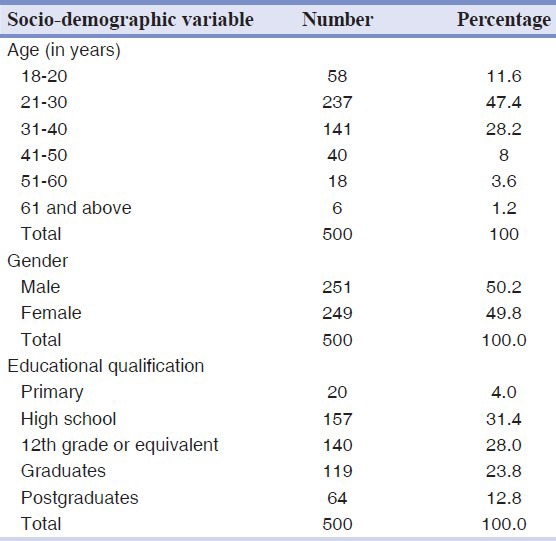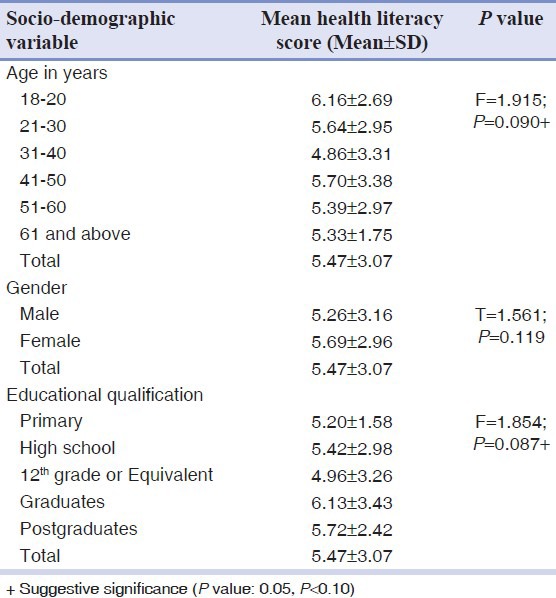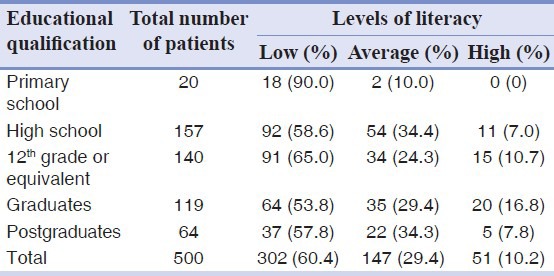Abstract
Background:
Poor literacy can impede one's ability not only to seek out needed health information but also to process, understand and use it to make appropriate health care decisions. The objective of the study was to assess the health literacy among adult patients seeking oral health care at in a private dental hospital in Bangalore, Karnataka, India.
Materials and Methods:
A cross sectional questionnaire survey was carried out on 500 subjects. The questionnaire designed by Chew and colleagues (2004) was modified and used as the survey instrument. To be eligible to participate in the study, the participants had to be aged above 18 years and able to read or write English/Kannada (local language). Analysis of variance (ANOVA) and Student's t-test (two tailed, independent) was used to find the significance of study parameters at 95% confidence interval.
Results:
About 60.4% of the subjects had low health literacy level, 29.4% average and only 10.2% had high health literacy levels. Age and educational qualification had a suggestive significant difference with the mean health literacy scores while gender did not have any significant difference. Subjects who had completed post-graduation (57.8%) too had low health literacy levels.
Conclusion:
A large number of patients have low levels of health literacy that may interfere with their ability to process and understand basic health information.
Keywords: Health information, health literacy, health providers
INTRODUCTION
Over the past several decades, researchers’ understanding of the causes and treatment of diseases has grown exponentially. However, there are profound and consequential health disparities globally. Apart from the financial issues, lack of access to providers, and cultural factors which are most often cited, literacy is one of the prime social determinants. Literacy has recently emerged as a key item on the research agenda in medicine and public health.
The growth in information technology and the rapid advances in scientific knowledge require that the public have an ever-increasing understanding of diseases to make good decisions about their health. Poor literacy can impede one's ability not only to seek out the needed health information but also to process, understand and use it to make appropriate health care decisions.[1] Health literacy is defined as ‘the degree to which individuals have the capacity to obtain, process, and understand basic health information and services needed to make appropriate health decisions’.[2]
As with general health, achieving and maintaining oral health requires one to be able to understand, interpret and act on various types of health information. Oral health communications (brochures, forms, and providers’ explanations of procedures and treatments, for example) are often dense, unnecessarily technical, and full of jargon, obscured by words like “pharynx,” “orally,” “occlusal” and “contraindications” instead of more familiar terms used in everyday speech. As a result, these communications are often difficult to understand, especially for individuals with limited literacy skills. This situation creates a significant barrier to improved oral health, exacerbating other barriers such as those related to economics, insurance coverage, and access.[3]
A survey is needed to determine the level of oral health literacy among members of the public and its effect on their ability to make good decisions about oral health. An understanding of health literacy and how it differs among dental patients is an important beginning step in determining the relative importance of this barrier to oral health and how it might be addressed in dental practice. The objective of this study was to assess the health literacy among adult patients seeking oral health care at The Oxford Dental College, Hospital and Research Centre, Bangalore, Karnataka, India.
MATERIALS AND METHODS
A cross-sectional study using a 13-item structured questionnaire was conducted to assess the health literacy in a sample of adult patients (n = 600) seeking care at the outpatient department, The Oxford Dental College, Hospital and Research Centre, Bangalore. The questionnaire was a modified questionnaire developed by Chew and colleagues.[4]
The data was collected during April-May 2009. To be eligible for the study, patients had to speak and read English/Kannada (local language) and be older than 18 years. The patients’ participation was voluntary. The patients’ were informed about the research undertaken and assured that their reluctance to participate in the study would not affect their treatment. Ethical approval for the study was obtained from the Institutional Ethical Committee. A pilot study was conducted on 10% of the study population. The questionnaire was pre-tested for validity, reliability and modified accordingly. The reliability was 0.815 (good reliability).
The questionnaire included the two sections. Section 1 was regarding the socio-demographic details of the study subjects. Section 2 comprised of 13 questions, the answers of which were graded on a 5 point Likert scale (a-e). Answers were dichotomized into whether health literate or not. Descriptive statistical analysis was carried out in the present study. Results on continuous measurements were presented as Mean + Standard Deviation and results on categorical measurements were presented in number and percentage. Significance was assessed at 5% level of significance. Analysis of variance (ANOVA) was used to find the significance of study parameters between three or more groups of patients and Student's t-test (two tailed, independent) was used to find the significance of study parameters on continuous scale between two groups (Inter group analysis) at 95% confidence interval.
RESULTS
A total of 500 adult patients (above 18 years of age) who were literate in English/Kannada (local language) attending The Oxford Dental College, Hospital and Research Centre participated in the study. The response rate was 83.3%. Table 1 summarizes the socio-demographic characteristics of the study participants. The age of the subjects ranged between 18-61 years. Among them 251 (50.2%) were males and 249 (49.8%) were females. Educational qualification distribution showed that 4% of the study subjects had completed primary school education, 31.4% completed high school (10th grade), 28% had completed 12th grade or equivalent (Diploma in Industrial Training Institute), 23.8% were graduates and 12.8% had completed post graduation.
Table 1.
Socio-demographic and baseline characteristics of the study participants

Table 2 shows the mean health literacy score according to different variables (age, gender and educational qualification). Mean health literacy score according to age and educational qualification showed a suggestive significance (0.05 < P < 0.01). There was no significant difference between mean health literacy score and gender.
Table 2.
Mean health literacy score according to different variables (age, gender, educational qualification)

Among the subjects studied, 60.4% had low health literacy level, 29.4% were average and only 10.2% had high health literacy levels [Table 3]. The graduates were better off compared to the others. About 53.8% of the graduates had low health literacy levels and 29.4% had average health literacy levels. It is surprising to note that 57.8% of the postgraduates had low health literacy levels [Table 4].
Table 3.
Levels of health literacy in the patients studied

Table 4.
Levels of health literacy in different education category

DISCUSSION
Oral health is an integral part of overall health and well being. As stated in Oral Health in America: A report of Surgeon General, “Just as we now understand that nature and nurture are inextricably linked, and mind and body are both expressions of our human biology, so too, we must recognize that oral health and general health are inseparable… No one can be truly health unless he or she is free from burden of oral and craniofacial diseases and conditions”.[5]
India is a developing country with a population of approximately 1 billion. The oral diseases constitute a considerable public health problem in India not only causing pain, agony, functional and esthetic problems but also limit social interactions and affects psychology and economy of individuals, families and society. According to the National Oral Health Survey of India (2002-2003), more than 50% of the population in all age groups suffers from dental caries and periodontal disease. Oral cancer accounts to about 0.3% in 35-44 years age group and 0.4% in 65-74 years age group. About 0.8% in 35-44 years age group and 29.5% in 65-74 years age group are edentulous.[6]
There are many reasons why these preventable oral diseases are so widespread and why people do not adopt practices that have been scientifically shown to be effective in maintaining oral health. While citing other factors like cultural, financial etc., literacy or more specifically health literacy emerges as one of the major key issues. The literacy rate in India is 65% as per the 2001 census.[7] When addressing health literacy, it is important that a nation's literacy level is improved first and subsequently the health and the oral health literacy. Kerala, a small state in southern India has the highest literacy rate of 90.92% with improved health outcomes when compared to the whole nation.[8] Increase in health literacy leads to adoption of effective disease prevention methods, successful adherence to treatment regimen and ultimately improved oral health status.
Oral health literacy is now believed to be an important determinant of oral health, one that intersects with other determinants in myriad ways. Although, literacy is not the only pathway to better oral health outcomes, it is certainly an important avenue. Hence, any effort to improve oral health outcomes should take into account the oral health literacy of the patient.[3] For effective disease management and maintenance of oral health, one must be able to understand, interpret, and act on health information, whether it is communicated verbally or in written form.
Very few studies have been reported on health literacy in dental settings. The limited research that has been done focuses mostly on assessing the reading level of dental educational materials and consent forms.[9] Unlike other studies found in literature[9,10,11,12,13,14,15] where the authors have used the readability scales (REALD, TOFHLA, STOHFLA), the present study used a questionnaire which was developed and validated by Chew and colleagues[4] (2004) to identify patients with low literacy levels.
The results of this study suggest that a large number of patients have low levels of oral health literacy among patients in Bangalore, India that may interfere in their ability to process and understand basic oral health information. About 40% of the patients have problems getting to the hospital at the right appointment time because of the difficulty in reading appointment slips, 52% of subjects agree that they have difficulty learning about their general/oral health conditions because of difficulty in understanding written information. Around 63% of the patients feel that they are not confident in taking the medication (s) correctly because of problems in understanding written instructions on bottle label and 64% of the subjects agreed that they require help to read hospital materials. Studies have linked low oral health literacy with worse oral health outcomes such as oral health status[9] and dental neglect.[15]
Health education, a widely accepted approach in prevention of oral diseases, is a process of transmission of knowledge and skills necessary for improvement in quality of life. Health education can be delivered by either personal instruction or by the use of self-instruction manuals and audiovisual aids.[16] Whatever is the mode or method of health education, the effectiveness of the program lies in the fact that people need to understand and interpret it correctly to lead a good quality of life.
CONCLUSION
This study concluded that there is low level of health literacy among patients seeking oral health care at a private dental college in Bangalore, India. Preventive oral services might be less effective in patients with low literacy level because they do not understand the instructions or the importance of preventive procedures. Also, it is to be noted that higher educational qualification does not necessarily mean that the person has to be a health literate. Hence, providers need to identify patients who are having difficulty understanding and using oral health information and should take steps to address their needs. These steps might include strategies such as receiving continuing education in effective patient communication techniques and ensuring that educational materials for patients are written at an appropriate reading level. It is thus important to realize that limited literacy is not an individual deficit. There is a need to look at the health literacy in the context of large systems–social systems, cultural systems, education systems and public health systems. Further investigation is needed to develop appropriate intervention strategies to improve oral health literacy for better oral health outcomes.
Footnotes
Source of Support: Nil
Conflict of Interest: None declared
REFERENCES
- 1.Jones M, Lee JY, Rozier RG. Oral health literacy among adult patients seeking dental care. J Am Dent Assoc. 2007;138:1199–208. doi: 10.14219/jada.archive.2007.0344. [DOI] [PubMed] [Google Scholar]
- 2.Horowitz AM, Kleinman DV. Oral Health Literacy: The new imperative to better oral health. Dent Clin N Am. 2008;52:333–44. doi: 10.1016/j.cden.2007.12.001. vi. [DOI] [PubMed] [Google Scholar]
- 3.A Report of a Workgroup Sponsored by the National Institute of Dental and Craniofacial Research, National Institutes of Health, U. S. Public Health Service, Department of Health and Human Services. The Invisible Barrier: Literacy and Its Relationship with Oral Health. J Public Health Dent. 2005;65:174–82. doi: 10.1111/j.1752-7325.2005.tb02808.x. [DOI] [PubMed] [Google Scholar]
- 4.Chew LD, Bradley KA, Boyko EJ. Brief Questions to Identify Patients with Inadequate Health Literacy. Fam Med. 2004;36:588–94. [PubMed] [Google Scholar]
- 5.Surgeon General Report 2000. Oral Health in America [Google Scholar]
- 6.Bali RK, Mathur VB, Talwar PP, Chanana HB. National Oral Health Survey and Fluoride Mapping (2002-2003), India [Google Scholar]
- 7.Government of India (2001). Census of India 2001. Provisional population totals, Paper – 1 of 2001 [Google Scholar]
- 8.Park K. 19th ed. Jabalpur, India: Bhanot Publishers; 2007. Park's Textbook of Preventive and Social Medicine. [Google Scholar]
- 9.Lee J, Rozier R, Lee S, Bender D, Ruiz R. Development of a word recognition instrument to test health literacy in dentistry: The REALD-30: A brief communication. J Public Health Dent. 2007;67:94–8. doi: 10.1111/j.1752-7325.2007.00021.x. [DOI] [PubMed] [Google Scholar]
- 10.Richman J, Lee J, Rozier R, Gong D, Pahel B, Vann W., Jr Evaluation of a word recognition instrument to test health literacy in dentistry: the REALD-99. J Public Health Dent. 2007;67:99–104. doi: 10.1111/j.1752-7325.2007.00022.x. [DOI] [PubMed] [Google Scholar]
- 11.Gong DA, Lee JY, Rozier RG, Pahel BT, Richman JA, Vann WF., Jr Development and Testing of the Test of Functional Health Literacy in Dentistry (TOFHLiD) J Public Health Dent. 2007;67:105–12. doi: 10.1111/j.1752-7325.2007.00023.x. [DOI] [PubMed] [Google Scholar]
- 12.Jackson RD, Eckert GJ. Health Literacy in an Adult Dental Research Population: A Pilot Study. J Public Health Dent. 2008;68:196–200. doi: 10.1111/j.1752-7325.2007.00063.x. [DOI] [PubMed] [Google Scholar]
- 13.Parker EJ, Jamieson LM. Associations between Indigenous Australian oral health literacy and self-reported oral health outcomes. BMC Oral Health. 2010;10:3. doi: 10.1186/1472-6831-10-3. [DOI] [PMC free article] [PubMed] [Google Scholar]
- 14.Divaris K, Lee JY, Baker AD, Vann WF. The relationship of oral health literacy with oral health-related quality of life in a multi-racial sample of low-income female caregivers. Health Qual Life Outcomes. 2011;9:108. doi: 10.1186/1477-7525-9-108. [DOI] [PMC free article] [PubMed] [Google Scholar]
- 15.Lee JY, Divaris K, Baker D, Rozier RG, Vann WF., Jr The relationship of oral health literacy with oral health status and dental neglect. Am J Public Health. 2012;102:923–9. doi: 10.2105/AJPH.2011.300291. [DOI] [PMC free article] [PubMed] [Google Scholar]
- 16.Hebbal M, Ankola AV, Vadavi D, Patel K. Evaluation of knowledge and plaque scores in school children before and after health education. Dent Res J. 2011;8:189–96. doi: 10.4103/1735-3327.86036. [DOI] [PMC free article] [PubMed] [Google Scholar]


